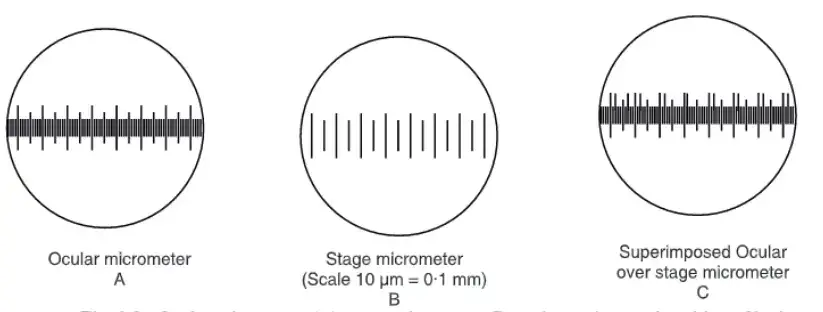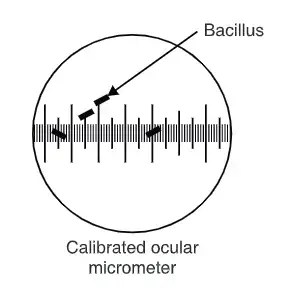Contents
Micrometry Definition
Micrometry is the art of measurement of the size that any visible microscopic microorganism. Micrometry actually is built on the principles of physical science. In the event that we can determine the dimensions of a given scale, the size of an unknown scale can be determined. Similar to this is the case with micrometry. The primary components utilized in micrometry include the stage micrometer and the ocular micrometer.
Ocular Micrometer
The Ocular Micrometer is a round disc that is placed inside the eyepiece (ocular). It is divided into several smaller pieces i.e. divisions marked from 0 to 100. The microscope is located in the eyepiece of a microscope. The distance of the lens varies with the focus that the lens has. It is easy to determine the distance by using a stage microscope.
Stage Micrometer
Stage Micrometers are glass slides that has been graduated by 1 mm i.e. the scale is only 1 millimeter (1000 millimeters). Also, 1 mm is broken down into 10 major divisions and 100 smaller divisions. One large division is split into 10 smaller divisions (hence 10×10 =100 divisions). The divisions are equally spaced. Thus, the smallest number is 0.01 millimeters (or 1000/100 = 10mm). This means that every smaller micrometer of stage is equivalent to 10 mm. The measurement of microorganisms is completed in the two steps that follow:
Calibration and Standardisation of Microscope by using Ocular Micrometer and Stage micrometer
Micrometer Principle
A microscope comes with an objective of 10X (low power) 45X (high power) and 100X (oil immersion). and the ocular lens with 5X, 10X and 15X. In general, an 10-X ocular lens is used in most cases. If an animal can be clearly seen with 10X ocular lens and 45X objective, this means that the size is 10×45, which is 450 times larger than the standard one. We don’t know the exact measurement is ? It could be determined using an calibrated scale. Thus the calibration of all lenses (eyepieces) is performed.
Requirements
- A microscope
- Ocular micrometer
- Stage micrometer
Procedure
Calibration of low power lens (10X): Use a 10X lens inside the objective, and then follow the steps below.
- Remove your eyepiece (ocular) installed with a microscope. Open the screw.
- Insert the ocular micrometer into the ocular. Close the screw, then put it back in the tube of the microscope.
- Place the stage microscope on the microscope’s stage.
- Adjust the mirror, condensor, ocular , and the objective (10X, 45X , or 100X) that are being calibrated.
- Examine the microscope under the lens and then focus the microscope properly using precise adjustments. Two different scales for the stage and ocular micrometers are visible.
- The ocular should be turned so it is parallel to the lines on both micrometers can be made parallel.
- Now, you can focus on the superimposed scales, and then coincide an arc on the left and observe the line that is coincided to the right.
- Find how many ocular divisions which coincide with the lines from both the ocular micrometers and stage micrometers.
- Take at least 5-6 readings, following the steps from 6 to 8.
Results
Record the reading as given in Table 2, and calculate average value of 1 division of ocular
| No. of divisions of ocular micrometer | No. of divisions of stage micrometer | Value of one division of ocular micrometer (um) |
| 10 | 15 | 15 |
Suppose, 10 divisions of ocular micrometer = 15 divisions of stage micrometer
1 division of ocular micrometer = 15/10 = 1.5 divisions of stage micrometer
Since, 1 division of stage micrometer = 10 mm
1.5 division of stage micrometer = 1.5 x 10 = 15 um
However, it may be calculated by using the following formula:


- Calibration of high power lens (45X): Use a the high power lens (45X) of the objective. Follow the instructions above to calibrate a low-power lens.
- Calibration of oil immersion (100X) : Use an ounce of oil for immersion in the stage micrometer. Turn the lens’s mouth over it, and then focus it by using the fine adjustments. Calculate the value of one division on the Ocular Micrometer, as previously described for lenses with low power.
Measurement of Dimension (size) of the Given Microorganism (bacilli)
After the ocular micrometer has been calibrated in the manner described above the dimensions of any microorganism can be determined easily by measuring the area occupied by microorganisms’ cells or filament and then multiplying that number with the calibrator factor for the ocular micrometer.
Requirements
- Prepared slide of a microorganism (bacilli)
- Ocular micrometer
- Stage micrometer
- Microscope
- Immersion oil
- Xylene
Procedure
- Be careful, place the ocular micrometer calibrated inside the eyepiece, then put it back into the microscope’s tube.
- Place one drop of oil into the middle of the slide prepared with bacteria it will be measured and focused in a way that is correct.
- The total number of Ocular Divisions which is contained in one cell of Bacillus. The size of the cells is 5-10 and then take an average of it.
- Find out the precise size of the bacteria by multiplying it by the calibration value of the ocular micrometer.
Results
For example, if Bacillus cells are located within four divisions of the an ocular micrometer and the calibrated value of the micrometer in the ocular is 2.2um the length of the bacillus will measure 4 x 2.2 = 8.8 um.












